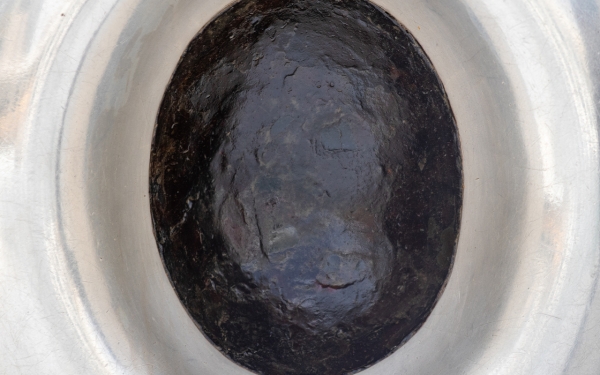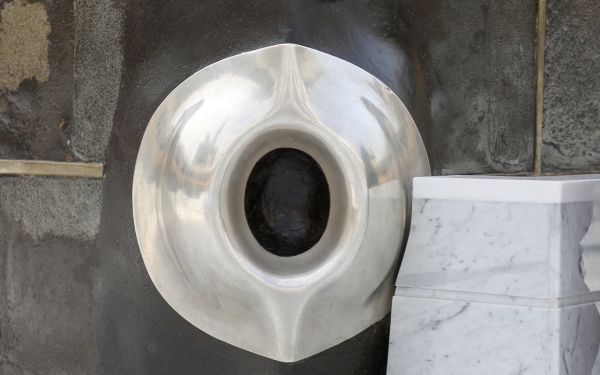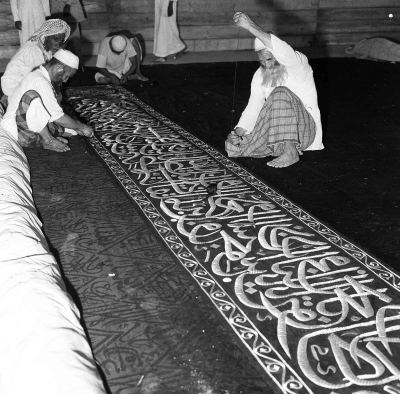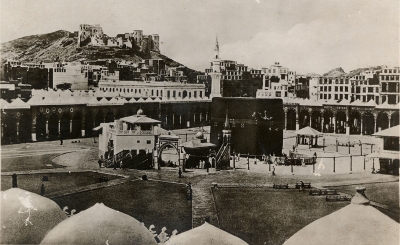

The Black Stone is a sacred stone for Muslims. It was sent down from heaven and placed in the southeastern corner of al-Kaaba al-Musharrafa in ancient times, adjacent to the Yamani corner on the eastern side of al-Kaaba. It marks the beginning and end of the Tawaf (circumambulation). It comprises eight fragments from its surface, assembled together in different shapes and encased by a silver frame, appearing in an oval shape.
The claim is that there are fifteen pieces in total, with the remaining seven pieces concealed beneath a brown paste visible to every recipient of the stone. This paste is composed of a blend of wax, musk, and amber, applied on the surface of the stone. The maintenance and perfuming of the Black Stone is overseen regularly by a qualified and specialized technical team from the General Presidency for the Affairs of the Grand Mosque and the Prophet's Mosque.
The Black Stone in the Islamic culture
The descent of the Black Stone
Jibreel peace be upon him (PBUH) brought the Black Stone down from the sky, and it moved through several historical epochs until it was placed at one corner of al-Kaaba. Its initial descent was during the time of Adam (PBUH) when he settled on Earth. Then, in the era of Noah (PBUH), Jibreel placed the stone on top of Mount Abu Qubais, a mountain near the Grand Mosque. Afterward, Jibreel handed the stone from Mount Abu Qubais to Ibrahim (PBUH) when he was building al-Kaaba al-Musharrafa. Ibrahim then placed it in its current position.
It is mentioned in the book Tafsir of Ibn Jarir, the book al-Mustadrak by al-Hakim, and other sources about the construction of al-Kaaba and the placement of the Black Stone in the era of Ibrahim (PBUH) that a man asked Ali Ibn Abi Talib (may Allah be pleased with him), "Would you tell me about the House? Is it the first House on earth?" He then answered: "No, however, it is the first House in which blessings were placed. In there is Maqam Ibrahim (Shrine of Ibrahim), whoever enters it is secure. If you wish, I will inform you how it was built. Indeed, Allah revealed to Ibrahim to build a House for Him on earth". Ali continued: "Ibrahim grew weary of the situation, and in response, Allah dispatched the Sakina (tranquility) - a formidable, two-headed wind. One head of the wind followed the other until it reached Makkah, encircling the sacred site of the House like a grip. Allah then instructed Ibrahim to construct the House where the Sakina had settled. Ibrahim began building, but was short of one stone, prompting his son to seek a solution. Ibrahim advised him, No, find me a stone, as I instruct you. The boy set off to find a stone, and when he returned, he found that the Black Stone had been set in its place. He asked his father, 'O father, who brought this stone?' Ibrahim replied, 'It was brought to me by one who does not rely on your construction.' Jibreel brought it from the sky, and they completed its placement".
Description of the Black Stone
The Black Stone is a radiant white gem that descended from Paradise. Some historians described its size and color. Mohammed al-Khazai mentioned that the length of the stone is that of an arm, and its color is white with a black head. Ibn Alan described the stone found in the construction of al-Kaaba as white as the brightness of the Maqam, referring to the Maqam of Ibrahim (PBUH). Its length is half an arm, its width is one-third of an arm, and its thickness is four Qirats. According to some narrations, there are about fifteen pieces of the Black Stone in the corner of al-Kaaba. Eight small pieces of varying sizes are visible, with the largest of these stones being about the size of a date, fixed in the corner with a paste that is black with a hint of red or brown. This paste is made from wax, amber, and musk. The stone is surrounded by a frame made of pure silver, oval in shape, with a diameter of about thirty cm. The stone rises about one and a half m above the ground of the Mataf. The rest of the stone is found within the structure of al-Kaaba.
Reason behind the Black Stone's name
The reason it's called the Black Stone is because before it descended from paradise, its color was whiter than snow, but the sins and wrongdoings of humans darkened it. Ibn Abbas, may Allah be pleased with him, narrated: The Messenger of Allah (PBUH) said: "The Black Stone descended from paradise, and it was whiter than milk, but the sins of the descendants of Adam made it black." In another narration: "The Black Stone descended from paradise, it was whiter than snow until the sins of polytheism people turned it black." It's also narrated that before descending from paradise, it was white, but Allah dimmed its light upon descent. Abdullah Ibn Amr Ibn al-Aas, may Allah be pleased with him, mentioned a hadith from the Prophet (PBUH) in which he said: "Indeed, the Black Stone and the Maqam are two rubies from the rubies of paradise. Allah dimmed their light. If it were not for that, they would illuminate the area between the East and the West."
The religious significance of the Black Stone
The religious significance of the Black Stone lies in the fact that Muslims emulate this nusuk from the actions of the Prophet (PBUH) who used to kiss the Stone during his Tawaf (circumambulation). It's narrated that Umar, may Allah be pleased with him, approached the Black Stone and kissed it. He said: "I know that you are a stone that neither harms nor benefits. Had I not seen the Prophet (PBUH) kiss you, I would not have kissed you". Thus, it is recommended, if not difficult, to touch and kiss the Black Stone at the beginning of each circuit during Tawaf. If this is difficult, one may simply point to the Black Stone, say Allahu Akbar. This is in accordance with what is reported about the Prophet (PBUH) that he would touch both the Black Stone and the Yamani Corner in every Tawaf. As for the reward for touching and kissing it, Ibn Abbas, may Allah be pleased with him, narrated that the Prophet (PBUH) said: "Indeed, this stone has a tongue and two lips, and it will bear witness on the Day of Judgment for the one who touched it with due right." In another hadith, the Prophet (PBUH) said: Wiping the Black Stone and the Yamani Corner (of al-Kaaba) removes sins.
Historical events involving the Black Stone
The fire incident during the era of Ibn Zubair
Prophet Muhammed (PBUH) placed the Black Stone in its position during the construction of al-Kaaba by Quraysh before his prophethood. It remained in its place until al-Kaaba fire incident that occurred during the era of Abdullah Ibn Zubair. At that time, the army of al-Husayn Ibn Numayr besieged them. The fire caused some cracks in the Stone. However, Ibn Zubair reinforced the corner with silver. In 805, during the reign of Harun al-Rashid, the silver became soft, and there was a fear that the corner might collapse. Therefore, Harun al-Rashid ordered the stone to be pierced with diamond drills and filled with silver.
Qarmatians and the Black Stone
The Black Stone witnessed a significant event in 929 when the Qarmatians, led by Abu Tahir Sulaiman Bin Abi Sa'id, launched an attack on Makkah al-Mukarramah. They caused havoc and committed a great massacre. They killed pilgrims near al-Kaaba and around it. They looted the covering of the Kaaba and the relics of the caliphs. They filled up Zamzam Well, broke the Black Stone, uprooted it from its place, and took it to their land "Hajr." It was mentioned in the books that during its transportation, forty camels were killed underneath it. The Black Stone stayed with the Qarmatians for over twenty years before it returned to al-Kaaba al-Musharrafa on Eid al-Adha in 950, after the death of Abu Tahir al-Qarmati due to smallpox in the same year. It was reported that the camel that was loaded to transport it was initially weak, but then it became strong and fat.
The Black Stone in 974
The incident of the man who came from the land of the Romans with the intention of stealing the Black Stone in 974. While circumambulating, there was a man, or possibly two men, the Roman man approached the Black Stone, and when he got close, he struck it with a mallet. When he tried to strike the stone again, a man from the people of Yemen intervened and killed him.
The Black Stone in 1023
On a Friday in 1023, the Black Stone was attacked. After the Imam finished the prayer, a man coming from Egypt approached the Black Stone pretending to touch it. He had a sharp sword and a mace with him. He struck the stone three times with the mace, causing people to be alarmed and disturbed by his intention to destroy the sacred structure. A man rose against him and killed him with a dagger, and those accompanying him were also killed.
The Black Stone during the reign of King Abdulaziz
The Black Stone was stolen in May 1932 by a Persian man, who extracted a piece of the Black Stone along with a piece of al-Kaaba's cover, in addition to stealing silver from al-Kaaba's staircase. However, the guards of the Grand Mosque managed to catch him. The Founder, King Abdulaziz Bin Abdulrahman Al Saud, restored the stone to its place on August 30, 1932.
The Black Stone in light of Saudi Arabia's capabilities for artificial intelligence
The Black Stone and artificial intelligence
The Agency for Exhibition and Museum Affairs at the General Presidency for the Affairs of the Grand Mosque and the Prophet's Mosque launched the virtual reality initiative for visitors to the exhibition of the architecture of the Two Holy Mosques. The project was developed by a group of young researchers from the Custodian of the Two Holy Mosques Institute for Hajj and Umrah Research. It allows visitors to virtually explore the details of the Grand Mosque with high precision using Virtual Reality (VR) and Augmented Reality (AR) technology. By wearing the device's special glasses, users can see al-Kaaba al-Musharrafa and its surroundings, such as the Black Stone, the Yamani Corner, the Shadhrwan, and the tiling of the Grand Mosque. Additionally, they can hear the call to prayer and even smell the fragrance of al-Kaaba. This experience aims to educate, enrich, and raise awareness among visitors to the Grand Mosque. It also aims to keep up with the digital transformation in line with Saudi Vision 2030.
Capturing the Black Stone
The General Presidency for the Affairs of the Grand Mosque and the Prophet's Mosque, through the Engineering Projects and Studies Agency, contributed by taking approximately 1,050 photos of the Black Stone and Maqam Ibrahim (PBUH). The photography was done using the Focus-Stacking Panorama technique, known for its high clarity and precision, with 49,000 megapixels. Each image had a size of around 160 GB. This was achieved by utilizing laser scanning technology to create a high-resolution computer model. The photography process took seven hours, followed by a week of continuous work for adjustments and final processing. The result of the photography revealed unprecedented details of the Black Stone and al-Maqam in remarkable precision and clarity.
Saudi Arabia's role in caring for the Black Stone
The frame of the Black Stone
The Kingdom's government has shown great care and attention to the frame surrounding the Black Stone. This frame, made of pure silver, serves as protection and preservation. It has been replaced twice: first during the reign of King Khalid Bin Abdulaziz Al Saud in 1979, and the second time during the reign of King Fahd Bin Abdulaziz Al Saud in 2001.
Organizational plan for kissing the Black Stone
The General Presidency for the Affairs of the Grand Mosque and the Prophet's Mosque has developed an advanced organizational plan to regulate the process of visitors kissing the Black Stone. A guard stands beside the stone, relying on a sturdy rope to assist in organizing and guiding the pilgrims in the correct manner of kissing the Stone.
Maintenance of the Black Stone
The General Presidency for the Affairs of the Grand Mosque and the Prophet's Mosque takes regular care of the Black Stone through a qualified and specialized technical team. They execute these tasks using modern and advanced methods, in accordance with high-quality standards in task performance and completion. This includes the use of modern technologies and internationally specified materials, along with precise methods to accomplish the tasks related to al-Kaaba al-Musharrafa and its surroundings.
Related quizzes


